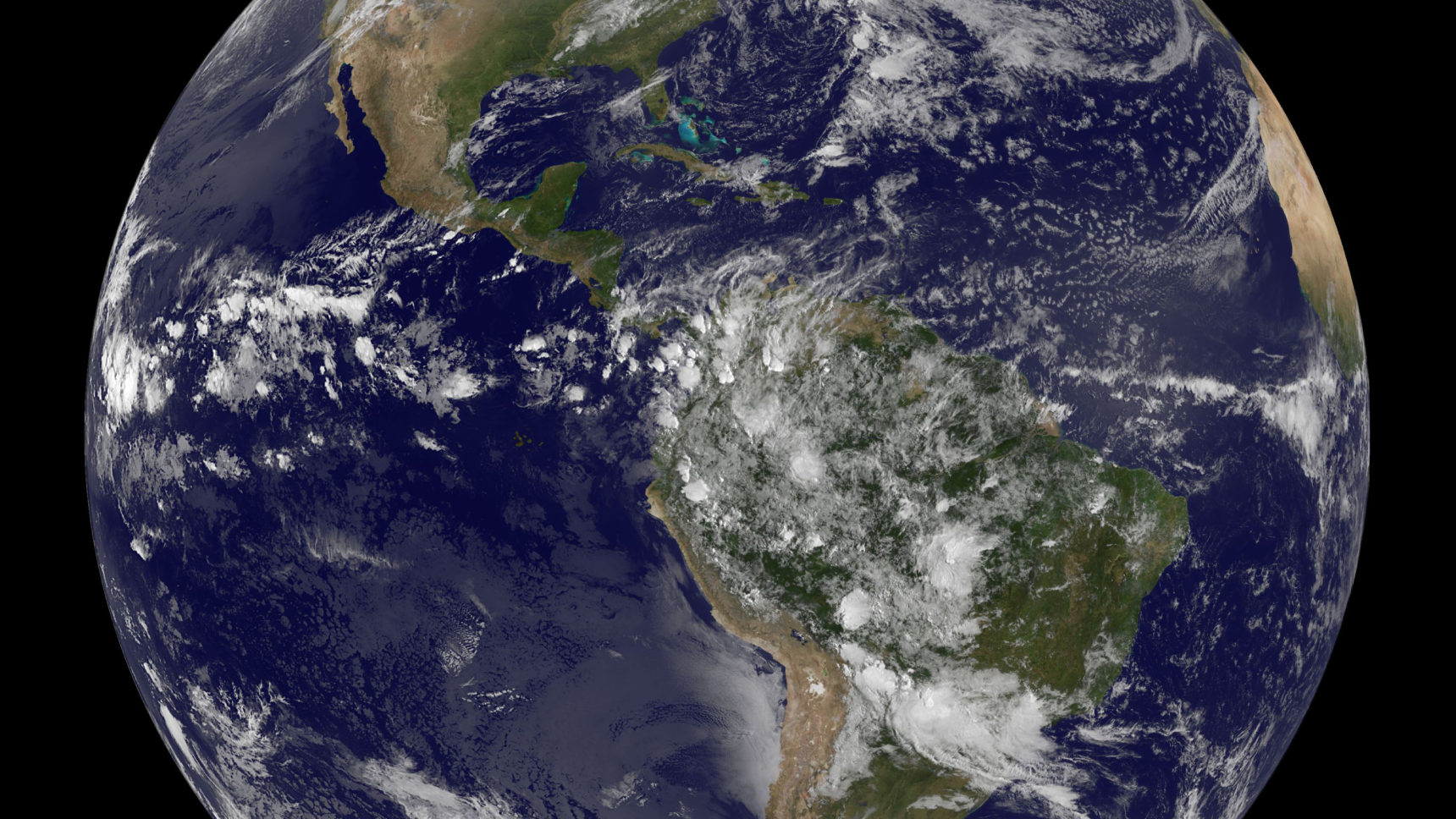To Solve the Biggest Mystery in Physics, Join Two Kinds of Law

James O’Brien for Quanta Magazine
Introduction
Suppose aliens land on our planet and want to learn our current scientific knowledge. I would start with the 40-year-old documentary Powers of Ten. Granted, it’s a bit out of date, but this short film, written and directed by the famous designer couple Charles and Ray Eames, captures in less than 10 minutes a comprehensive view of the cosmos.
The script is simple and elegant. When the film begins, we see a couple picnicking in a Chicago park. Then the camera zooms out. Every 10 seconds the field of vision gains a power of 10 — from 10 meters across, to 100, to 1,000 and onward. Slowly the big picture reveals itself to us. We see the city, the continent, Earth, the solar system, neighboring stars, the Milky Way, all the way to the largest structures of the universe. Then in the second half of the film, the camera zooms in and delves into the smallest structures, uncovering more and more microscopic details. We travel into a human hand and discover cells, the double helix of the DNA molecule, atoms, nuclei and finally the elementary quarks vibrating inside a proton.
The movie captures the astonishing beauty of the macrocosm and microcosm, and it provides the perfect cliffhanger endings for conveying the challenges of fundamental science. As our then-8-year-old son asked when he first saw it, “How does it continue?” Exactly! Comprehending the next sequence is the aim of scientists who are pushing the frontiers of our understanding of the largest and smallest structures of the universe. Finally, I could explain what Daddy does at work!
Powers of Ten also teaches us that, while we traverse the various scales of length, time and energy, we also travel through different realms of knowledge. Psychology studies human behavior, evolutionary biology examines ecosystems, astrophysics investigates planets and stars, and cosmology concentrates on the universe as a whole. Similarly, moving inward, we navigate the subjects of biology, biochemistry, and atomic, nuclear and particle physics. It is as if the scientific disciplines are formed in strata, like the geological layers on display in the Grand Canyon.
Moving from one layer to another, we see examples of emergence and reductionism, these two overarching organizing principles of modern science. Zooming out, we see new patterns “emerge” from the complex behavior of individual building blocks. Biochemical reactions give rise to sentient beings. Individual organisms gather into ecosystems. Hundreds of billions of stars come together to make majestic swirls of galaxies.
As we reverse and take a microscopic view, we see reductionism at work. Complicated patterns dissolve into underlying simple bits. Life reduces to the reactions among DNA, RNA, proteins and other organic molecules. The complexity of chemistry flattens into the elegant beauty of the quantum mechanical atom. And, finally, the Standard Model of particle physics captures all known components of matter and radiation in just four forces and 17 elementary particles.
Which of these two scientific principles, reductionism or emergence, is more powerful? Traditional particle physicists would argue for reductionism; condensed-matter physicists, who study complex materials, for emergence. As articulated by the Nobel laureate (and particle physicist) David Gross: Where in nature do you find beauty, and where do you find garbage?
Take a look at the complexity of reality around us. Traditionally, particle physicists explain nature using a handful of particles and their interactions. But condensed matter physicists ask: What about an everyday glass of water? Describing its surface ripples in terms of the motions of the roughly 1024 individual water molecules — let alone their elementary particles — would be foolish. Instead of the impenetrable complexities at small scales (the “garbage”) faced by traditional particle physicists, condensed matter physicists use the emergent laws, the “beauty” of hydrodynamics and thermodynamics. In fact, when we take the number of molecules to infinity (the equivalent of maximal garbage from a reductionist point of view), these laws of nature become crisp mathematical statements.
While many scientists praise the phenomenally successful reductionist approach of the past centuries, John Wheeler, the influential Princeton University physicist whose work touched on topics from nuclear physics to black holes, expressed an interesting alternative. “Every law of physics, pushed to the extreme, will be found to be statistical and approximate, not mathematically perfect and precise,” he said. Wheeler pointed out an important feature of emergent laws: Their approximate nature allows for a certain flexibility that can accommodate future evolution.
In many ways, thermodynamics is the gold standard of an emergent law, describing the collective behavior of a large number of particles, irrespective of many microscopic details. It captures an astonishingly wide class of phenomena in succinct mathematical formulas. The laws hold in great universality — indeed, they were discovered before the atomic basis of matter was even established. And there are no loopholes. For example, the second law of thermodynamics states that a system’s entropy — a measure of the amount of hidden microscopic information — will always grow in time.
Modern physics provides a precise language to capture the way things scale: the so-called renormalization group. This mathematical formalism allows us to go systematically from the small to the large. The essential step is taking averages. For example, instead of looking at the behavior of individual atoms that make up matter, we can take little cubes, say 10 atoms wide on each side, and take these cubes as our new building blocks. One can then repeat this averaging procedure. It is as if for each physical system one makes an individual Powers of Ten movie.
Renormalization theory describes in detail how the properties of a physical system change if one increases the length scale on which the observations are made. A famous example is the electric charge of particles that can increase or decrease depending on quantum interactions. A sociological example is understanding the behavior of groups of various sizes starting from individual behavior. Is there wisdom in crowds, or do the masses behave less responsibly?
Most interesting are the two endpoints of the renormalization process: the infinite large and infinite small. Here things will typically simplify because either all details are washed away, or the environment disappears. We see something like this with the two cliffhanger endings in Powers of Ten. Both the largest and the smallest structures of the universe are astonishingly simple. It is here that we find the two “standard models,” of particle physics and cosmology.
Remarkably, modern insights about the most formidable challenge in theoretical physics — the push to develop a quantum theory of gravity — employ both the reductionist and emergent perspectives. Traditional approaches to quantum gravity, such as perturbative string theory, try to find a fully consistent microscopic description of all particles and forces. Such a “final theory” necessarily includes a theory of gravitons, the elementary particles of the gravitational field. For example, in string theory, the graviton is formed from a string that vibrates in a particular way. One of the early successes of string theory was a scheme to compute the behavior of such gravitons.
However, this is only a partial answer. Einstein taught us that gravity has a much wider scope: It addresses the structure of space and time. In a quantum-mechanical description, space and time would lose their meaning at ultrashort distances and time scales, raising the question of what replaces those fundamental concepts.
A complementary approach to combining gravity and quantum theory started with the groundbreaking ideas of Jacob Bekenstein and Stephen Hawking on the information content of black holes in the 1970s, and came into being with the seminal work of Juan Maldacena in the late 1990s. In this formulation, quantum space-time, including all the particles and forces in it, emerges from a completely different “holographic” description. The holographic system is quantum mechanical, but doesn’t have any explicit form of gravity in it. Furthermore, it typically has fewer spatial dimensions. The system is, however, governed by a number that measures how large the system is. If one increases that number, the approximation to a classical gravitational system becomes more precise. In the end, space and time, together with Einstein’s equations of general relativity, emerge out of the holographic system. The process is akin to the way that the laws of thermodynamics emerge out of the motions of individual molecules.
In some sense, this exercise is exactly the opposite of what Einstein tried to achieve. His aim was to build all of the laws of nature out of the dynamics of space and time, reducing physics to pure geometry. For him, space-time was the natural “ground level” in the infinite hierarchy of scientific objects — the bottom of the Grand Canyon. The present point of view thinks of space-time not as a starting point, but as an end point, as a natural structure that emerges out of the complexity of quantum information, much like the thermodynamics that rules our glass of water. Perhaps, in retrospect, it was not an accident that the two physical laws that Einstein liked best, thermodynamics and general relativity, have a common origin as emergent phenomena.
In some ways, this surprising marriage of emergence and reductionism allows one to enjoy the best of both worlds. For physicists, beauty is found at both ends of the spectrum.
This article was reprinted on Wired.com.




